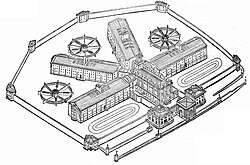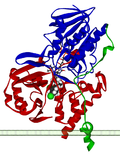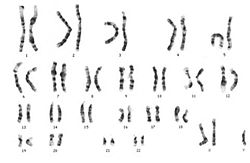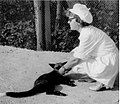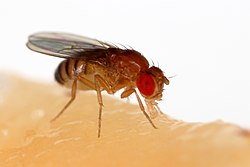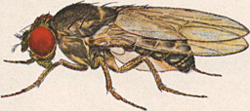Mice aggression studies have led to some interesting insight in human aggression. Using reverse genetics, the DNA of genes for the receptors of many neurotransmitters...
25 KB (3,136 words) - 21:49, 24 May 2025
conceptualize aggression as an internal energy released by external stimuli, a product of evolution through natural selection, part of genetics, a product of hormonal...
124 KB (15,009 words) - 19:35, 23 May 2025
Impulsivity (redirect from Genetics of impulsivity)
brain networks may contribute to different manifestations of impulsivity, and that genetics may play a role. Many actions contain both impulsive and compulsive...
142 KB (15,657 words) - 14:59, 22 May 2025
Criminology (redirect from Biological theories of criminology)
young men are most likely to exhibit criminal behavior. See also: genetics of aggression. Aggressive behavior has been associated with abnormalities in three...
67 KB (8,246 words) - 08:26, 25 May 2025
Siamese fighting fish (category National symbols of Thailand)
plain of Thailand, where they were first domesticated at least 1,000 years ago, among the longest of any fish. They were initially bred for aggression and...
83 KB (10,183 words) - 22:55, 22 May 2025
The frustration–aggression hypothesis, also known as the frustration–aggression–displacement theory, is a theory of aggression proposed by John Dollard...
36 KB (4,612 words) - 10:48, 24 May 2025
Rage syndrome (redirect from Sudden Onset Aggression)
dogs, characterized by explosive aggression. It is frequently confused with idiopathic aggression, a term for aggression with no identifiable cause. Rage...
20 KB (1,825 words) - 14:22, 24 May 2025
Tabby cat (category CS1 maint: DOI inactive as of November 2024)
patterns, each linked to genetics, are the mackerel, classic or blotched, ticked, and spotted tabby patterns. "Tabby" is not a breed of cat but a coat pattern...
27 KB (2,887 words) - 04:29, 21 May 2025
Monoamine oxidase A (redirect from Female variation of MOA-A oxidative effect in United States of America)
"Candidate genes for aggression and antisocial behavior: a meta-analysis of association studies of the 5HTTLPR and MAOA-uVNTR". Behavior Genetics. 44 (5): 427–44...
40 KB (4,659 words) - 12:25, 21 April 2025
John Paul Scott (geneticist) (category Alumni of the University of Oxford)
Paul (1958). Aggression (2nd Edition 1975) Scott, John Paul (1965). Genetics and the Social Behavior of the Dog. Dewsbury, Donald. "The Life of J.P. Scott"...
4 KB (360 words) - 13:52, 23 September 2024
pathology of the brain, where many mental disorders are conceptualized as disorders of brain circuits shaped by a complex interplay of genetics and experience...
68 KB (10,666 words) - 05:32, 23 May 2025
Neurogenetics (redirect from History of neurogenetics)
Neurogenetics studies the role of genetics in the development and function of the nervous system. It considers neural characteristics as phenotypes (i...
30 KB (3,387 words) - 18:18, 10 September 2024
Domesticated silver fox (category Domestication of particular species)
Darwin in On the Origin of Species. The experiment at the Institute of Cytology and Genetics in Novosibirsk, Russia, explored whether selection for behaviour...
44 KB (5,450 words) - 12:25, 11 May 2025
population genetics, demographic history, folklore, including oral traditions, linguistics, and other disciplines. The demographic history of Palestine...
132 KB (15,361 words) - 18:17, 29 May 2025
concepts of a Jewish identity were rarely addressed until recently. Questions of how political narratives impact the work of population genetics, and its...
143 KB (17,768 words) - 14:04, 22 May 2025
Self-domestication (section Reactive aggression)
self-domestication is the outcome of two different kinds of aggression: proactive and reactive aggression. Proactive aggression, which is commonly observed in chimpanzees...
20 KB (2,402 words) - 14:46, 23 May 2025
Drosophila melanogaster (category Diptera of North America)
Zwarts L, Versteven M, Callaerts P (January 1, 2012). "Genetics and neurobiology of aggression in Drosophila". Fly. 6 (1): 35–48. doi:10.4161/fly.19249...
141 KB (16,078 words) - 07:53, 31 May 2025
Wim Crusio (category Research directors of the French National Centre for Scientific Research)
Crusio WE (ed.). "Special issue: The neurobehavioral genetics of aggression". Behavior Genetics. 26 (5): 459–504. doi:10.1007/BF02359749. PMID 8917943...
35 KB (3,032 words) - 13:08, 23 May 2025
Cat (redirect from Feline Asocial Aggression)
only domesticated species of the family Felidae. Advances in archaeology and genetics have shown that the domestication of the cat occurred in the Near...
162 KB (16,573 words) - 01:43, 31 May 2025
Biosocial criminology (redirect from Behavioral genetics and crime)
criminology also recognizes the potential contributions of fields such as behavioral genetics, neuropsychology, and evolutionary psychology. Environment...
18 KB (2,223 words) - 00:53, 24 February 2025
Natural selection (redirect from Selection (genetics))
theories of genetics. The union of traditional Darwinian evolution with subsequent discoveries in classical genetics formed the modern synthesis of the mid-20th...
108 KB (11,709 words) - 09:36, 31 May 2025
often not possible.: 36 A number of factors combine to influence the development of sex differences, including genetics and epigenetics; differences in...
98 KB (11,706 words) - 18:51, 22 May 2025
Shyness (redirect from Genetics of shyness)
the subject of studies in both shyness and aggression and is currently the subject of studies on the "novelty seeking" trait. A 1996 study of anxiety-related...
46 KB (5,607 words) - 15:53, 17 March 2025
The genetics of social behavior is an area of research that attempts to address the question of the role that genes play in modulating the neural circuits...
15 KB (2,165 words) - 18:05, 3 November 2023
House mouse (category Rodents of Asia)
Male-male aggression occurs in commensal populations, mainly to defend female mates and protect a small territory. The high level of male-male aggression, with...
66 KB (7,652 words) - 11:31, 28 May 2025
Canine reproduction (redirect from Genitalia of dogs)
dogs less than 11 months of age that had previously shown signs of aggression are more likely to have an increase in aggression after being spayed. These...
42 KB (4,827 words) - 23:47, 24 May 2025
Huntington's disease (redirect from Genetics of Huntington's disease)
the experience of Huntington disease". American Journal of Human Genetics. 47 (1): 4–12. PMC 1683755. PMID 1971997. "Insurance Genetics Moratorium extended...
144 KB (15,037 words) - 10:27, 30 May 2025
Fruitless (gene) (category Behavioural genetics)
since it provokes discussion on genetics of human sexual orientation, and behaviors such as gender-specific aggression. Male flies with mutations in the...
8 KB (775 words) - 20:23, 9 March 2024
Drosophila (section Genetics)
Mediterranean fruit fly. One species of Drosophila in particular, Drosophila melanogaster, has been heavily used in research in genetics and is a common model organism...
63 KB (6,566 words) - 17:50, 22 May 2025
create a social order of dominance known as pecking order. When pressure occurs within the flock, pecking can increase in aggression and escalate to cannibalism...
19 KB (2,597 words) - 02:57, 14 February 2025



